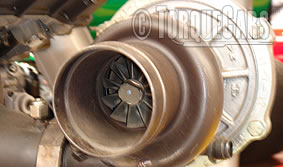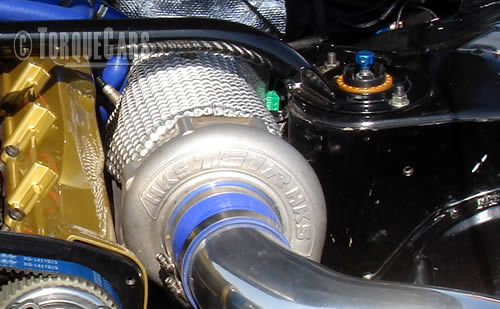What is a hybrid turbo?
"A new breed of Turbo"

When you have a turbo engine you are actually starting out with a fantastic base to work from.
As a rule the turbo engines are stronger than the NASP equivalents and are able to handle substantial power gains.
The key thing in a turbo engine is the flow rate that can be generated and this depends largely on the internal profiles of the impellers inside the turbo.
When you want to increase the turbo capacity you have two options. Firstly you can fit a larger turbocharger, but this will usually require a lot of custom pipe work as the oil feed, exhaust manifold and intakes are in different locations.
Your other option is to go with a hybrid turbo. A hybrid turbo is a drop in replacement for the OEM turbo but the internals have been altered to suit your power requirements.
By altering the profile of the exhaust side impeller you can get the turbo to spool up more quickly, provide a longer power band or more top end power. It is usually a compromise as you are generally unable to get all of these benefits and will need to choose the best option to suit.
Also alterations to the intake compressors profile can have a dramatic effect on how much air can be pulled into the engine.
There are two types of bearings used in turbos. Thrust bearings and ball bearings. Most OEM turbos use thrust bearings as these are cheaper to produce but when a lot of extra power is put through them they can start to fail and you get oil leaks and premature turbo wear.

A ball bearing turbo will usually spool up more quickly than a thrust bearing one and will be able to handle much more power. Not all OEM turbo housings can be modified and converted from a thrust bearing to ball bearing, instead an OEM shaped turbo unit is made to accommodate the uprated internals.
We should also note that the air intake opening shape also has a bearing on the flow characteristics of the turbo. Any steps, pits or seams in the metal surface can cause turbulence which will ruin your airflow characteristics.
Here are the pros and cons to consider when specifying the characteristics of your hybrid turbo.
+points High end power -points Bottom end power and you will get more lag.
+points Bottom end power & Faster spool up -points the top end power will usually be compromised.
+points Longer power band -points The peak power figure will be slightly lower and there may be a little more lag.
Other considerations on adding a hybrid turbo.
You will need to consider your peak power carefully as hybrid turbos are generally graded into power bands. You'll also need a remap to fully release the potential power gains of your turbo although most cars will cope with a hybrid turbo on a standard map. When the boost levels run beyond what the ECU expects a car may go into a limp home mode so for this reason alone a remap makes good sense.
Just pushing more air into the engine is not enough as it needs to be matched to the fuel supplied as well. Uprating the injectors and fuel pump along with a higher pressure fuel line will make good sense.
Standard engines can generally cope with power hikes in the region of 30-40% but anymore than this and you should consider fitting forged internal engine parts, particularly the pistons, crank and rods.
You can discuss hybrid turbos with our members in our technical forum if you have any further questions or wish to see what other people have done to their cars.
Please Check out my YouTube channel, we're regularly adding new content...
PLEASE HELP: I NEED YOUR DONATIONS TO COVER THE COSTS OF RUNNING THIS SITE AND KEEP IT RUNNING. I do not charge you to access this website and it saves most TorqueCars readers $100's each year - but we are NON PROFIT and not even covering our costs. To keep us running PLEASE Donate here
If you liked this page please share it with your friends, drop a link to it in your favourite forum or use the bookmarking options to save it to your social media profile.
Feedback - What do You Think?
Please use our forums if you wish to ask a tuning question, and please note we do not sell parts or services, we are just an online magazine.
Help us improve, leave a suggestion or tip
Please watch this video and subscribe to my YouTube channel.
2 Responses to “Hybrid turbos”

 Click to accept YouTube Cookies & Play.
Click to accept YouTube Cookies & Play.
Hello, found this article very helpful. There is just one thing i dont understand? how do you know what turbo fits what. I have a mitsubishi lancer 2.0 diesel 2008. I dont know what bigger turbo i can put in there? 🙂
With custom pipe work/custom manifold you can generally get any turbo to fit any car – but some are easier than others. You’ll need to note if the turbo requires an oil feed on the left/right and how much physical space there is for the turbo, in some cars there is not a lot of room to spare – generally the closer you get to the standard turbo setup the easier it is. Most hybrids use a standard housing so are a drop in replacement.